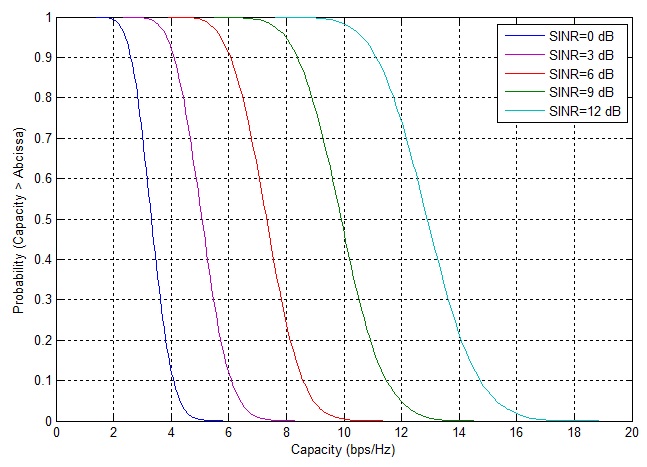The Shannon Capacity of a channel is the data rate that can be achieved over a given bandwidth (BW) and at a particular signal to noise ratio (SNR) with diminishing bit error rate (BER). This has been discussed in an earlier post for the case of SISO channel and additive white Gaussian noise (AWGN). For a MIMO fading channel the capacity with channel not known to the transmitter is given as (both sides have been normalized by the bandwidth [1]):
where NT is the number of transmit antennas, NR is the number of receive antennas, γ is the signal to interference plus noise ratio (SINR), INR is the NRxNR identity matrix and H is the NRxNT channel matrix. Furthermore, hij, an element of the matrix H defines the complex channel coefficient between the ith receive antenna and jth transmit antenna. It is quite obvious that the channel capacity (in bits/sec/Hz) is highly dependent on the structure of matrix H. Let us explore the effect of H on the channel capacity.
Let us first consider a 4×4 case (NT=4, NR=4) where the channel is a simple AWGN channel and there is no fading. For this case hij=1 for all values of i and j. It is found that channel capacity of this simple channel for an SINR of 10 dB is 5.36bits/sec/Hz. It is further observed that the channel capacity does not change with number of transmit antennas and increases logarithmically with increase in number of receive antennas. Thus it can be concluded that in an AWGN channel no multiplexing gain is obtained by increasing the number of transmit antennas.
We next consider a more realistic scenario where the channel coefficients hij are complex with real and imaginary parts having a Gaussian distribution with zero mean and variance 0.5. Since the channel H is random the capacity is also a random variable with a certain distribution. An important metric to quantify the capacity of such a channel is the Complimentary Cumulative Distribution Function (CCDF). This curve basically gives the probability that the MIMO capacity is above a certain threshold.

It is obvious (see figure above) that there is a very high probability that the capacity obtained for the MIMO channel is significantly higher than that obtained for an AWGN channel e.g. for an SINR of 9 dB there is 90% probability that the capacity is greater than 8 bps/Hz. Similarly for an SINR of 12 dB there is a 90% probability that the capacity is greater than 11 bps/Hz. For a stricter threshold of 99% the above capacities are reduced to 7.2 bps/Hz and 9.6 bps/Hz.
In a practical system the channel coefficients hij would have some correlation which would depend upon the antenna spacing. Lower the antenna spacing higher would be the antenna correlation and lower would be the MIMO system capacity. This would be discussed in a future post.
The MATLAB code for calculating the CCDF of channel capacity of a MIMO channel is given below.
clear all
close all
Nr=4;
Nt=4;
I=eye(Nr);
g=15.8489;
for n=1:10000
H=sqrt(1/2)*randn(Nr,Nt)+j*sqrt(1/2)*randn(Nr,Nt);
C(n)=log2(det(I+(g/Nt)*(H*H')));
end
[a,b]=hist(real(C),100);
a=a/sum(a);
plot(b,1-cumsum(a));
xlabel('Capacity (bps/Hz)')
ylabel('Probability (Capacity > Abcissa)')
grid on
[1] G. J. Foschini and M. J. Gans,”On limits of Wireless Communications in a Fading Environment when Using Multiple Antennas”, Wireless Personal Communications 6, pp 311-335, 1998.
